Displaying items by tag: Punt
Don Street of Glandore and the Caribbean celebrated his 90th Birthday in distance-compliant-style with the Glandore Dragons in July 2020. And as he has had his writings about sailing published regularly - both in books and magazines - since 1964, after being encouraged to go for it by no less than Nobel Laureate for Literature John Steinbeck, it is reckoned that he is now the world's senior practitioner of the ink-and-salt-water trade.
But while 2020 brought much pleasure and celebration, it also brought a special sadness, as the Street family lost an old friend. We let Don take up the tale:
"Forty years ago, my Venezuelan friends taught me how to say good-bye to sailing friends who had crossed the harbour bar for the last time on their long voyage to the sailors' Valhalla, where the winds are fair and warm, and the seas moderate.
You walk to the end of the pier with your favourite drink, hoist it as a toast to the departed friend, drink half, then pour the other half into the sea for the departed sailor.
 A time for celebration – all set up for Don Street's 90th birthday race in Glandore on July 25th 2020
A time for celebration – all set up for Don Street's 90th birthday race in Glandore on July 25th 2020
Glandore Harbour is sheltered in all directions except South East, so no one worried to much when a SW gale was predicted the night of October 17th 2020. Unfortunately, the gale must have had a lot of south and a little east of south in it. This created a big surge in the Harbour, and it was a full moon with a big spring tide.
Red Rocket, the Street family's 16' light clinker/lapstrake dinghy that had given 41 years of yeoman service to our family and many others in Glandore, was, along with a number of other boats, swept off the high inner pier wall and destroyed.
Bits and pieces of Red Rocket were spread over the harbour, and during the following days, some of the pieces drifted ashore. With my wife Trich, I decided we'd to give Red Rocket a proper send-off in the fashion with which I always said farewell to those sailing friends who have departed to the maritime Valhalla.
 In her sailing and racing days, the very handy Red Rocket really was painted a bright red. But even when painted with whatever colour happened to be available that year, she gave forty years in all of the unstinting good service
In her sailing and racing days, the very handy Red Rocket really was painted a bright red. But even when painted with whatever colour happened to be available that year, she gave forty years in all of the unstinting good service
The word spread through the village and beyond to as many sailors as possible who'd had a connection to Red Rocket. The plan was to assemble on Glandore pier at 1100 Saturday with their favourite drink in hand and properly say good-bye to Red Rocket while bits and pieces of her were still tossing in the harbour.
Before everyone hoisted their drinks. I told the story of Red Rocket. Many of the assembled sailors knew of parts of the Red Rocket saga, but few knew it all.
In 1979, it was the Golden Jubilee of the Irish Cruising Club, and in July, the Cruising Club of America, the Royal Cruising Club, and Scotland's Clyde Cruising Club assembled with the Irish Cruising Club at the Royal Cork Yacht Club in Crosshaven to begin a Cruise-in-Company westward to Glengarriff, where the ICC had been founded 50 years earlier.
All our cruising focus at the time was on the Caribbean, where our yawl Iolaire was based. But as we'd many friends we'd like to greet in this mixed fleet at Crosshaven, I calculated the tide for the Owenabue river and rented a rather non-descript dinghy from the dinghy rental service in Crosser two hours before high tide, so that with minimal rowing Trich and I could float upon the flood seeing friends on various boats, and then return with equal ease on the ebb, socialising and visiting.
There was a nice-looking clinker 16ft dinghy that I wanted to rent but was unable to do so because one oar was broken. When returning the non-descript dinghy we'd used, I again admired the 16ft dinghy, but the boat hire operator did not share my enthusiasm, as renters claimed it was too tippy. The upshot was he offered to sell the dinghy to me, with oar repaired and delivered to Glandore, for IR£150. I immediately agreed to buy.
 Red Rocket's workaday appearance successfully disguised a real thoroughbred, bought for just IR£150 in 1979
Red Rocket's workaday appearance successfully disguised a real thoroughbred, bought for just IR£150 in 1979
Upon arrival in Glandore, the horrible orange colour was changed to red, the same red as the 46' engineless yawl Iolaire. Iolaire was doing so well racing in the Caribbean that she was known as The Old Red Race Horse.
In the 70s and into the early 80s in West Cork, part of the town festivals that each port ran were rowing races with cash prizes. There were races for various age groups, all men, all women, and mixed. That first year, the dinghy earned more in prize money than I paid for her, but I never saw the money. The kids spent the winnings on chips and soda, the older contestants on booze and beer. By the end of the season, she was known as Red Rocket, a name that has stuck with her even though in her later years, after we'd sold Iolaire, she'd appear in whatever paint was available and latterly had been blue.
The boats that were rowed in the regattas were pretty much whatever could be found and usually quite heavy. So for my daughter, Dory, aged 16, and her friends, I rigged the 16ft Red Rocket to be rowed four-oared. She was the smallest four-oared boat in the circuit, and when the girls first started rowing as a team, Red Rocket looked like a drunken water spider. But they learned to row well and turned in respectable performances against the larger 20 and 22-foot boats.
The following year, Glandore Harbour Rowing Club commissioned Jackie Mons to build a light clinker 20' four-oared boat. In Cu na Mara, the Red Rocket-trained girls were practically unbeatable for three years until the team broke up and gals departed to university and out of Glandore.
In this period, there was little enough local sailing in Glandore except for Kieran, and Dermot O'Donohue match racing their two Dragons, Pan and Fafner. To get sailing, I rigged Red Rocket as a cat ketch, with a loose-footed lug as main, and a mizzen which was also a lug but unique in Glandore, as it was rigged Chesapeake Bay-style with a sprit, rather than a normal boom.
A single lee-board was rigged. It was secured on the lee side by water pressure on the hull, with the top secured to a line that went through a hole in the middle of the centre thwart. The leeboard was switched on every tack to the new lee side, and that was Sean Thompson's job, as he was the biggest and strongest and - at 13 - the oldest member of the crew, with the other two being Donald and Richard Street, aged 11 and 9.
Red Rocket was a great training boat with plenty of strings to pull, and she gained extra kudos among Glandore's growing group of junior sailors, as she was much faster than the expanding fleet of Optimists.
 The 1933-vintage Dragon Gypsy has provided both racing and sail training services to many generations in Glandore
The 1933-vintage Dragon Gypsy has provided both racing and sail training services to many generations in Glandore
But the lure of the Dragons couldn't be resisted, and I bought the 1933-vintage Anker & Jensen-built Gypsy. Red Rocket's sailing rig was discarded, and she became our water taxi for the next thirty-five years. All the crews of Gypsy not only learned to tie knots - many more knots that they learn in the ISA programme – but they also learn to row properly and enjoy it, too, while they kept our carbon footprint at zero as other kids buzzed noisily around with outboards on RIBS.
They learned to pivot Red Rocket in one spot, clock-wise and counter-clockwise, and also how to row in astern to back Red Rocket neatly into the crowded dinghy pontoon in the lee of the Glandore pier, as it is much easier to get in and out of a dinghy via the stern rather than over the bow. I had figured this out over forty years ago, and Iolaire's dinghies were always secured to the dock or float stern rather than bow on.
Sailors who had not previously crewed on Gypsy asked me why Red Rocket had beautiful white fendering all along the port gunwale, but nothing on the starboard side other than a couple of suspended blue fenders. I point out that I like and try to follow old yachting traditions. Owners and guest come on board on the starboard side. Paid hands and tradesmen on the port side….. We always board Gypsy on the starboard side. But alas, we will no longer do it from Red Rocket, and we bid farewell to her in traditional style, our faithful friend of forty years".
 Don Street waxes lyrical – his farewell to Red Rocket in a ceremony at the end of the pier brought the Caribbean to Glandore
Don Street waxes lyrical – his farewell to Red Rocket in a ceremony at the end of the pier brought the Caribbean to Glandore
You might think that in West Cork, which is something of Clinker Punt Central, replacing Red Rocket is proving an easy business as Don accelerates his search, having had his COVID-19 jab last week. But at 16ft overall, she was a slightly unusual length. For although 12 and 14 footers are common, there then seems to be a 4ft leap to the 18-19ft, which is the regular length of the standard Irish lake boat.
As well, though she may look quite heavily built, Red Rocket was surprisingly light, and Don would hope to continue that characteristic. Thus his choices are closely-defined. Perhaps a 16ft version of the edge-glued clinker ply Rankin dinghies of Cork Harbour might fit the bill?
Either way, Don prefers wood, and he likes a bargain, so you see the parameters of this challenge. But if you have or know of an available boat that comes anywhere near the now-legendary Red Rocket's many virtues, please contact Don Street at [email protected]
 A beautifully-restored 14ft Rankin sailing dinghy. Being built with edge-glued clinker ply, they're remarkably light, and a 16ft version of this boat with the same beam but without the centreboard casing might make an ideal replacement for Red Rocket
A beautifully-restored 14ft Rankin sailing dinghy. Being built with edge-glued clinker ply, they're remarkably light, and a 16ft version of this boat with the same beam but without the centreboard casing might make an ideal replacement for Red Rocket
It’s not every day you’re helped aboard a new boat by an international star of stage and screen writes W M Nixon. But it happened at the weekend in Baltimore, where A-list actor Jeremy Irons is now a quietly familiar part of the West Cork summer scene, and particularly the traditional and classic boat side of it.
So much so, in fact, that it would be unusual for an event such as last weekend’s Baltimore Woodenboat & Seafood Festival if this most noted of their local skippers didn’t sally forth to participate from his restored Kilcoe Castle, which is just round the corner on the shores of Roaringwater Bay.
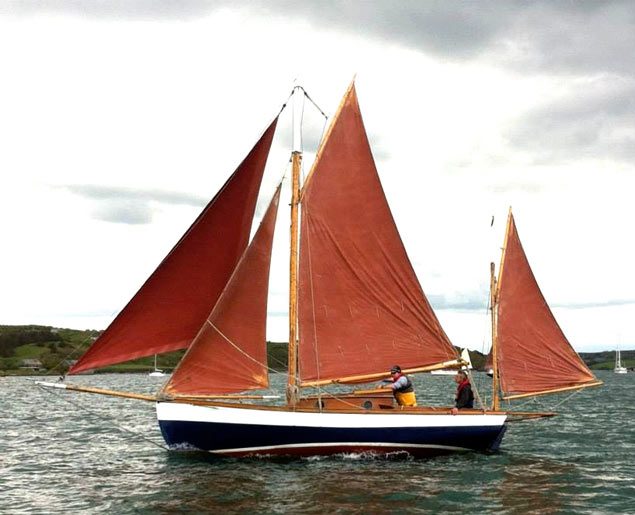 The pet boat. Jeremy Irons’ own sailing pride-and-joy in West Cork is the Willing Lass. As to her rig, the talk might go on all night as to whether she’s a ketch or a yawl.
The pet boat. Jeremy Irons’ own sailing pride-and-joy in West Cork is the Willing Lass. As to her rig, the talk might go on all night as to whether she’s a ketch or a yawl.
For those unfamiliar with the area, we hasten to say that the bay is named for the Roaringwater River which flows into it – Kilcoe Castle stands above reasonably serene waters, in the heart of an island-studded area where bustling Baltimore is within easy reach.
It was certainly beginning to bustle when the Ilen Boat-Building School of Limerick’s caravanserai – for no other word more aptly fills the bill – finally arrived in Baltimore with their eclectic collection of boats in tow or on trucks. And it was good to see that, as the larger fleet took up their berths at the harbour, there beside the quay was the familiar friendly shape of Jeremy Irons’ own little classic yawl, Willing Lass.
While the Ilen people had brought their usual range of Shannon gandelows and other craft, their little fleet in Baltimore included three dinghies of the Valentine Punt type, which originates from a 10ft punt built in 1926 at Passage West on Cork Harbour as a tender for John Valentine Sisk. His grandson Hal Sisk remembered so vividly the little boat’s wellnigh-perfect rowing ability, and her stability with remarkable load-carrying power, that he has made kits available to re-create the Valentine Punt in a much lighter Epoxy-built edge-glued version, which retains the use of clinker marine ply planks, but doesn’t require frames.
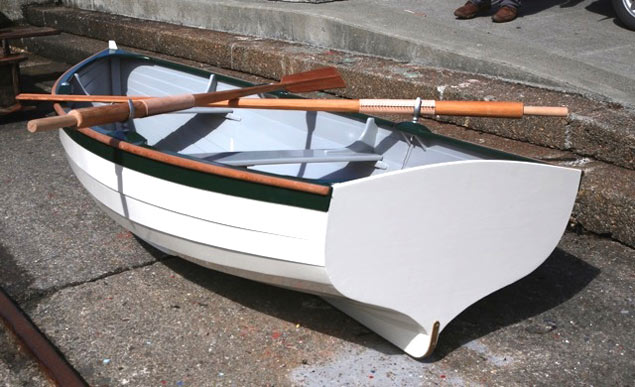 In honour of trainee boatbuilder Elan Broadley’s home county, the final touch of perfection for the new punt has been a Donegal green sheerstrake. Photo: Gary MacMahon
In honour of trainee boatbuilder Elan Broadley’s home county, the final touch of perfection for the new punt has been a Donegal green sheerstrake. Photo: Gary MacMahon
The Ilen Boat-Building School is always on the lookout for interesting new projects, so he donated one of the kits to its Limerick premises, and the job of building the boat was under-taken as a solo project by Elan Broadley from Donegal, with the school’s teacher Matt Dirr revealing his talents as a light-handed instructor.
For the young Donegal man, it was a lengthy and sometimes difficult process. But when the resulting 10ft punt was brought to the slip in Baltimore as the weather improved to a briskly sunny day on Saturday, it all became thoroughly worthwhile. The little boat simply looked a treat, the final perfection being a sheerstrake of Donegal green in honour of the builder.
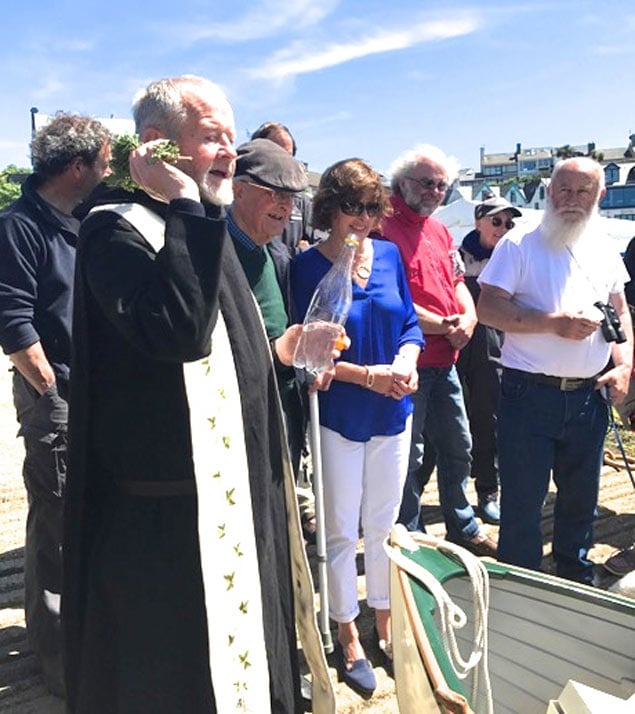 Brother Anthony of Glenstal Abbey blesses the new boat, assisted by Richard Bushe. Photo: Gary MacMahon
Brother Anthony of Glenstal Abbey blesses the new boat, assisted by Richard Bushe. Photo: Gary MacMahon
Elan’s mother Geraldine had come down from Donegal for this very special occasion, while Hal Sisk had come from Dun Laoghaire and leading traditional boat enthusiasts such as Paddy Barry had also travelled to be there with folk like Mary Jordan who keep the Baltimore Woodenboat show on the road, and it became one of those informal gatherings which somehow acquires its own momentum.
The boat was blessed by Brother Anthony Keane from Glenstal Abbey, who is a Director of the Ilen Boat-Building School, assisted by Richard Bushe on behalf of the Baltimore maritime community. A very special cake, dedicated to Hal and Matt, was ceremoniously sliced and consumed with enthusiasm, and then after the two other Valentine Punts had been sent off to row about in the inner harbour as a welcoming escort, the new boat took to the water for the first time.
 A very special cake gave thanks from Elan Broadley to Hal Sisk, the donor of the boat-building kit, and Matt Dirr the Ilen School Instructor. Photo: Gary MacMahon
A very special cake gave thanks from Elan Broadley to Hal Sisk, the donor of the boat-building kit, and Matt Dirr the Ilen School Instructor. Photo: Gary MacMahon
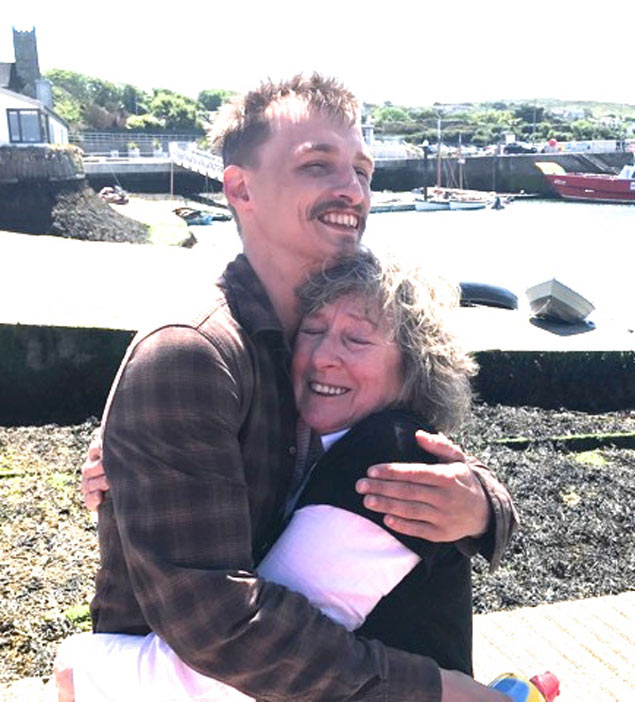 “Well done!” Mary Jordan of the Baltimore Woodenboat & Seafood Festival gives her warmest approval to Elan Broadley for his efforts. Photo: Gary MacMahon
“Well done!” Mary Jordan of the Baltimore Woodenboat & Seafood Festival gives her warmest approval to Elan Broadley for his efforts. Photo: Gary MacMahon
It was now that Hal Sisk reckoned he’d the perfect opportunity to demonstrate the Valentine Punt’s excellent load-carrying capacity, and somehow Jeremy Irons – who has long taken a close interest in the Ilen project – was roped in to help people aboard and send a worthwhile payload afloat. Like the good trouper he is, he threw himself into the role with relish, and the new dinghy – with Hal himself doing the rowing from the useful bow position – showed she could confidently carry six people, including the young boat-builder’s mother.
 Always a willing trouper – Jeremy Irons enthusiastically took on he role of quayside attendant and boat loader
Always a willing trouper – Jeremy Irons enthusiastically took on he role of quayside attendant and boat loader
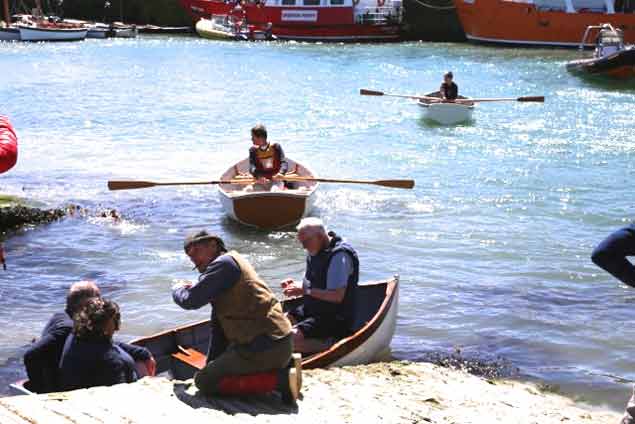 “Come on, there’s plenty of room for lots more......” Jeremy Irons piling them in, while the two sister-punts row out into the harbour. Photo: Gary MacMahon
“Come on, there’s plenty of room for lots more......” Jeremy Irons piling them in, while the two sister-punts row out into the harbour. Photo: Gary MacMahon
It’s not every day that you can travel all the way from Donegal to West Cork to see the first boat built by your son being launched in front of such an extraordinary and approving group. And then to be helped on board that same boat by a real international superstar successfully pretending to be a quayside attendant....well, it made Geraldine’s day.
In fact, it made everyone’s day. In this one charming little launching ceremony, the message of hope which is embodied in the Ilen Boat-Building School became clear for all to see, share and understand.
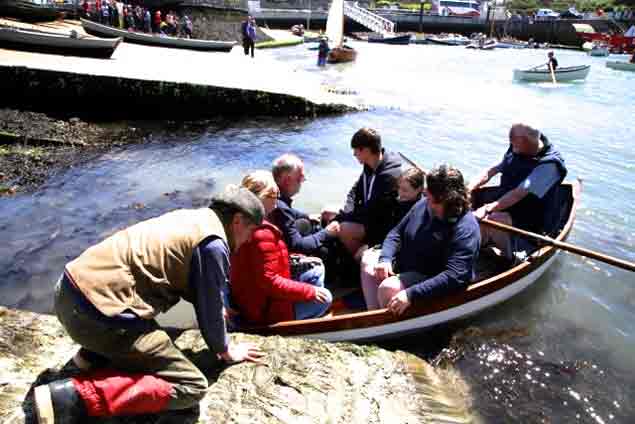 Sending them on their way – with Hal Sisk on the oars, the little punt takes the load. Photo: Gary McMahon
Sending them on their way – with Hal Sisk on the oars, the little punt takes the load. Photo: Gary McMahon
 Job done. Elan’s mother Geraldine (red jacket) floats for the first time in the punt her son built. In the interests of safety, they stayed strictly in the shallowest water, but the little punt carried the load very well. Photo: Gary MacMahon
Job done. Elan’s mother Geraldine (red jacket) floats for the first time in the punt her son built. In the interests of safety, they stayed strictly in the shallowest water, but the little punt carried the load very well. Photo: Gary MacMahon
#MCIB - Investigators have reiterated the importance of water safety measures such as wearing a lifejacket and having a means of alert when on or near the water in the report into the death of a man in Dundalk Harbour in February last year.
As previously reported on Afloat.ie, the man was understood to have taken a small punt from the mudflats at Soldiers Point to reach a colleague requiring his aid on another boat on the afternoon of Saturday 12 February 2012, but went missing after he capsized near Dundalk Lighthouse.
The official report into the indecent by the Marine Casualty Investigation Board (MCIB) names the man as Stephen Fergus, who was making his way to assist his friend Pat O'Brien, whose boat was suffering engine trouble and was anchored on the north side of the estuary at Dundalk Harbour.
Fergus was reported missing after O'Brien became concerned as to his whereabouts. After an extensive search of the estuary by the emergency services, Fergus' body and the submerged punt were found later that evening by the Drogheda unit of the Irish Coast Guard.
The subsequent post-mortem recorded Fergus' death as by drowning.
With no witnesses to the incident that brought about his death, it is assumed that Fergus was in the process of either getting into the punt or transferring from the punt to his own boat when the tragedy occurred.
It was noted that the canvas cover on his boat has not been disturbed, indicating that he did not gain access to the vessel before the incident.
The report's analysis concludes that the strong tidal current at the time would have made it difficult for Fergus to manoeuvre the punt to transfer to his boat single-handedly.
In addition, the condition of the mudflats where the punt was tied off were found to be changeable over time, with the mud in parts "arduous to walk on".
But the key finding of the investigation was that Fergus was neither wearing a lifejacket nor had any means of communication on his person at the time of the incident.
Two lifejackets were found in his car, and it was noted that he had left his mobile phone at home, presumably in the hurry to assist his friend.
The MCIB recommended that all owners and operators of recreational craft should be aware and follow the Code of Practice for the Safe Operation of Recreational Craft.
The full report is available to download as a PDF below.































































